
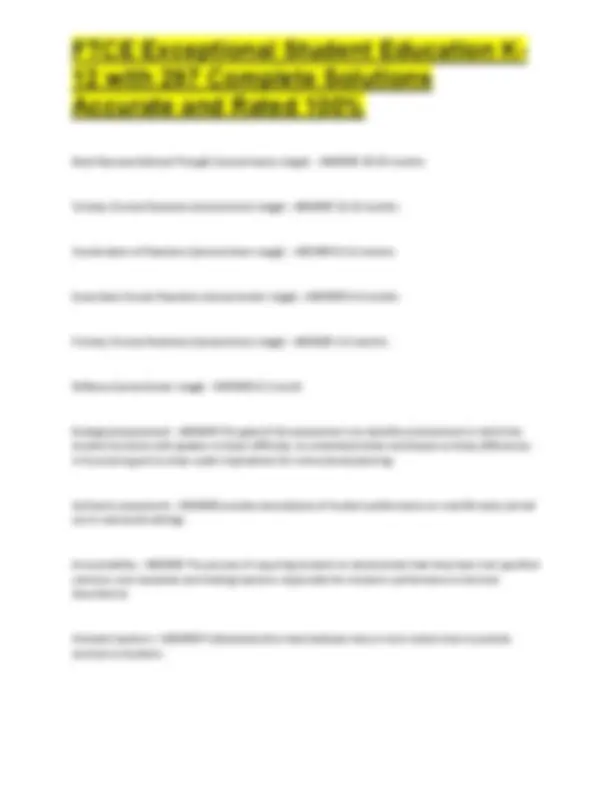
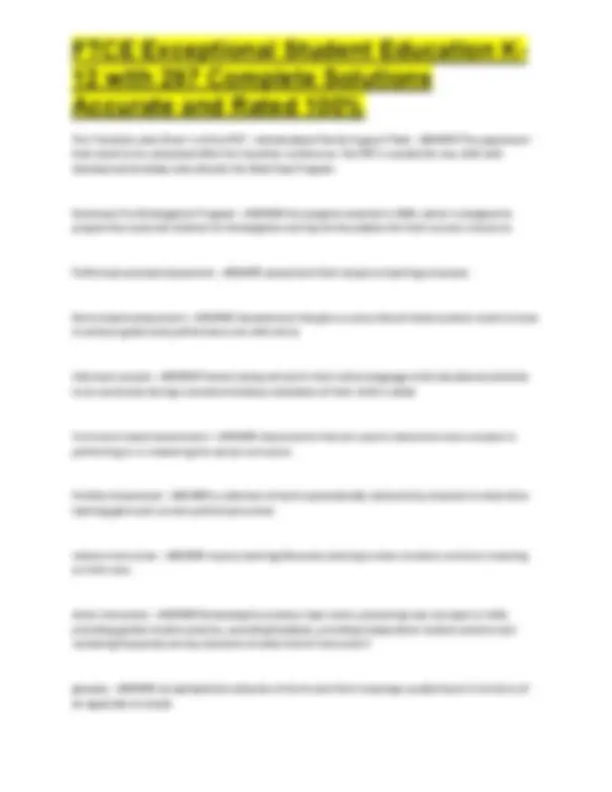
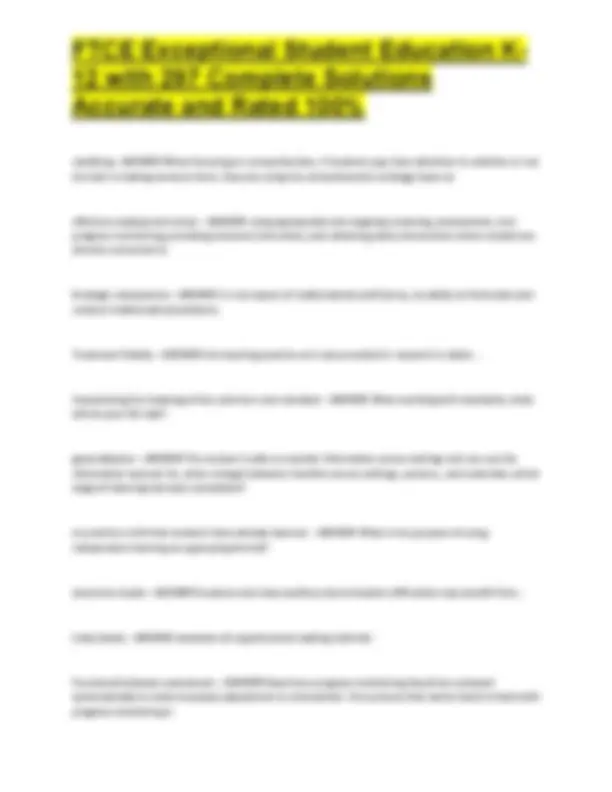
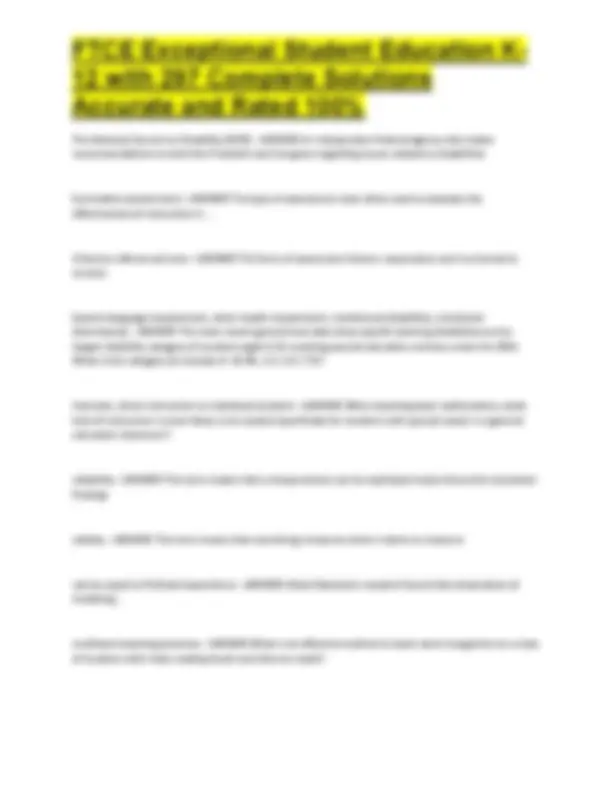
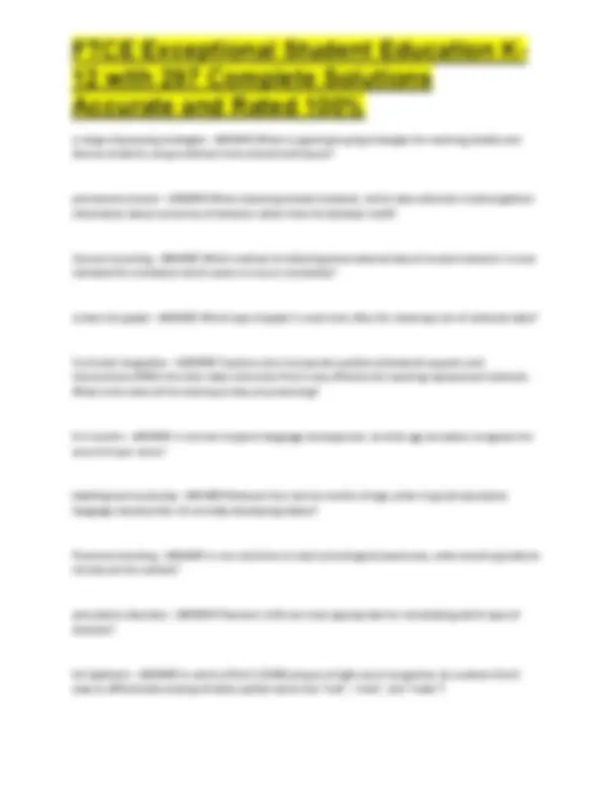
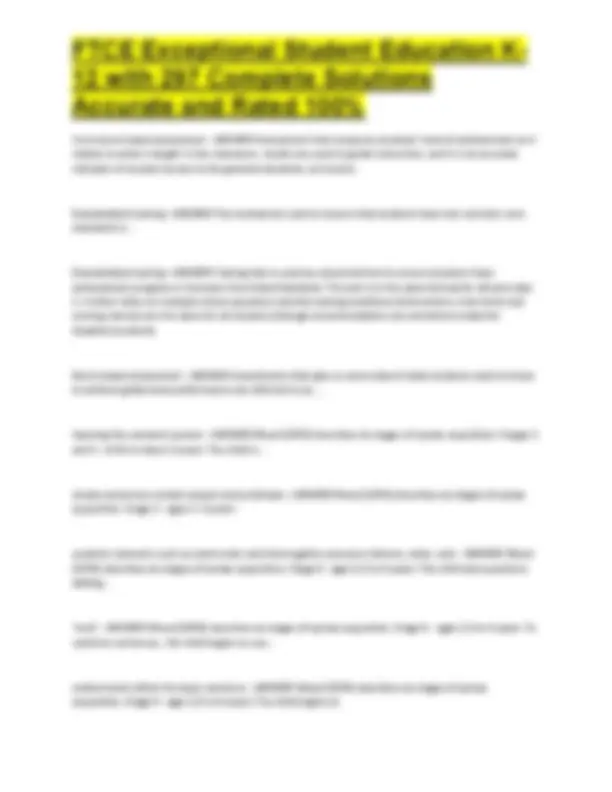
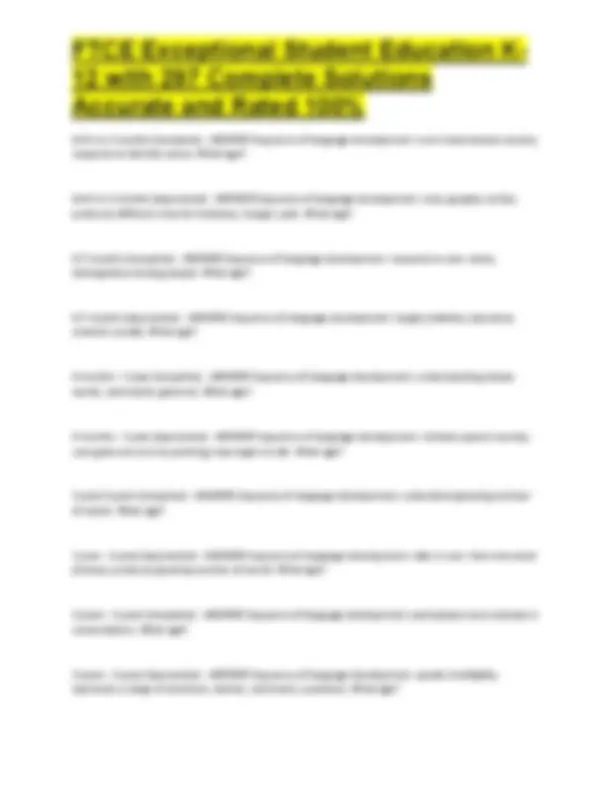
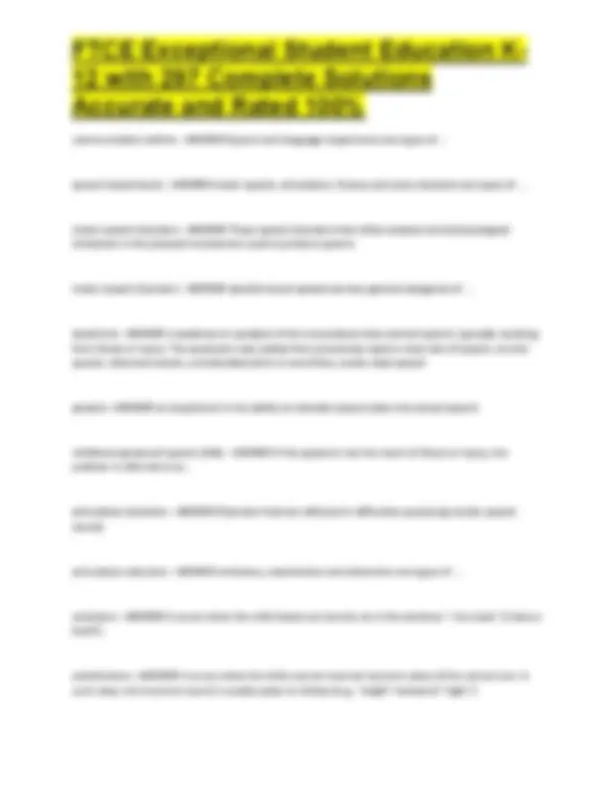
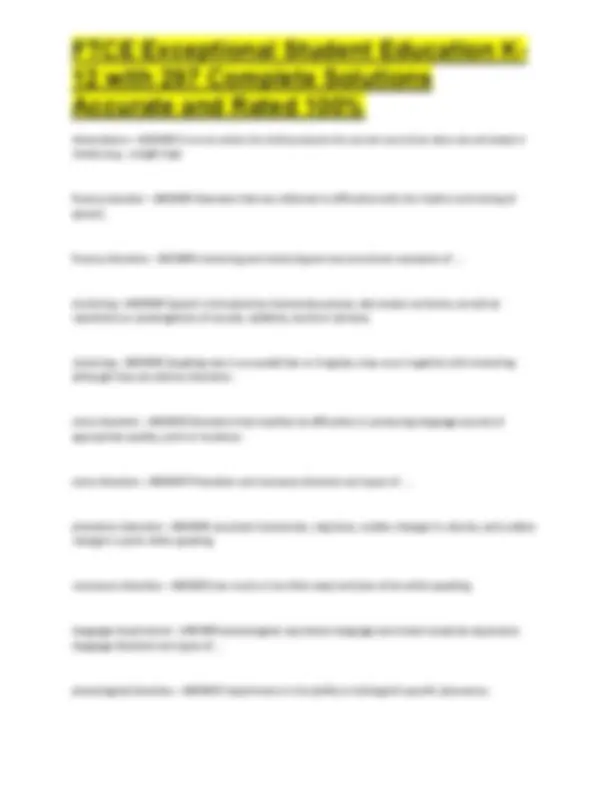
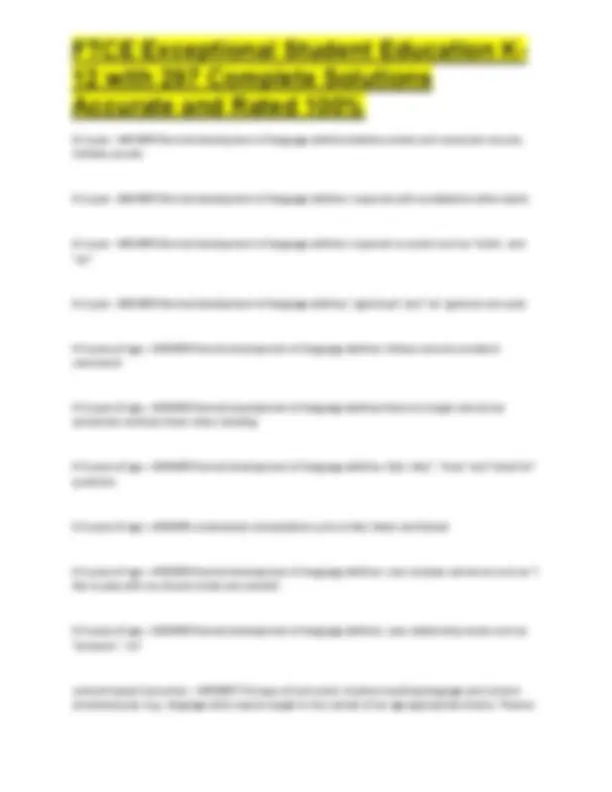
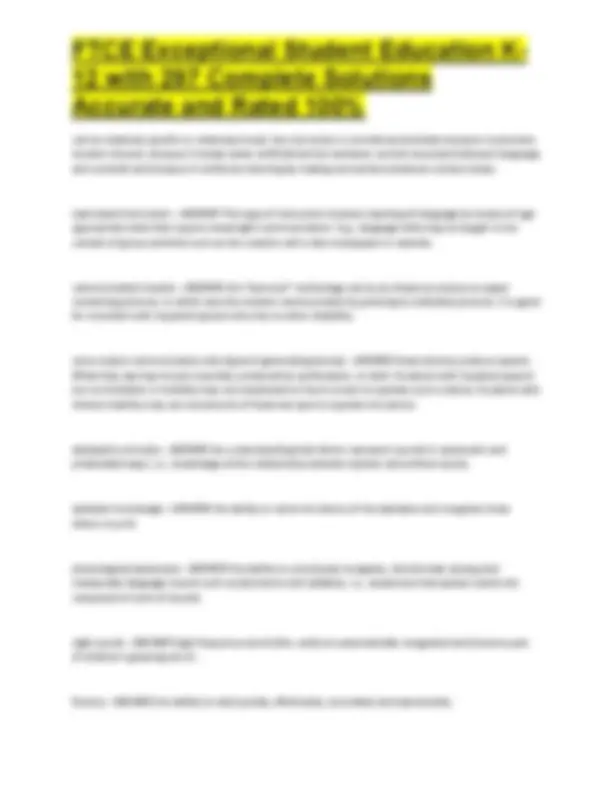
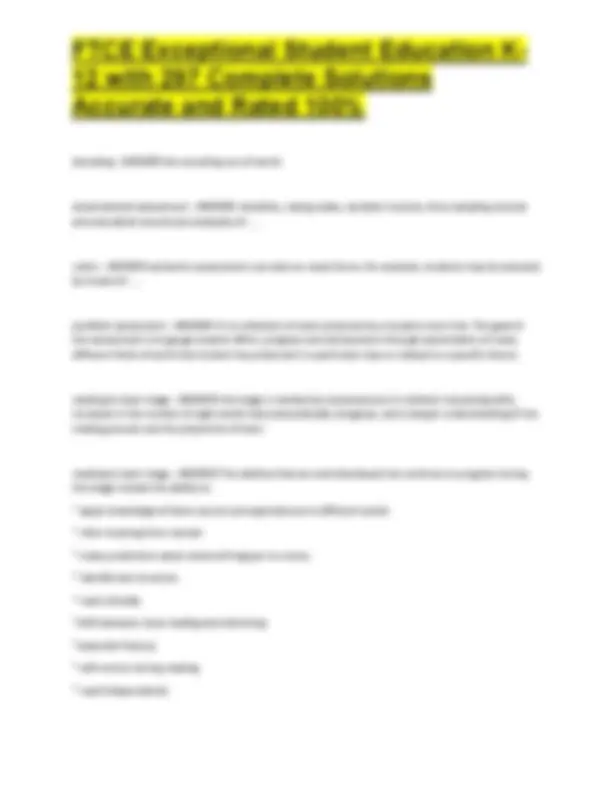
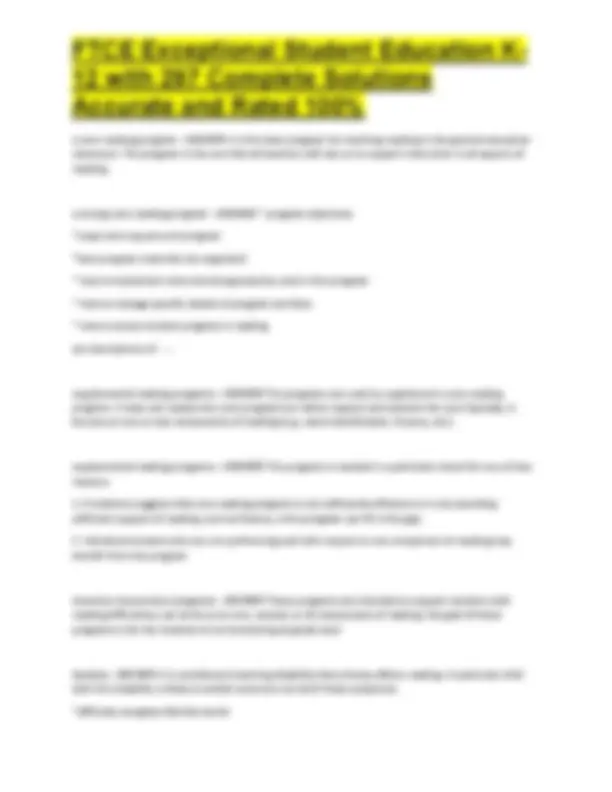
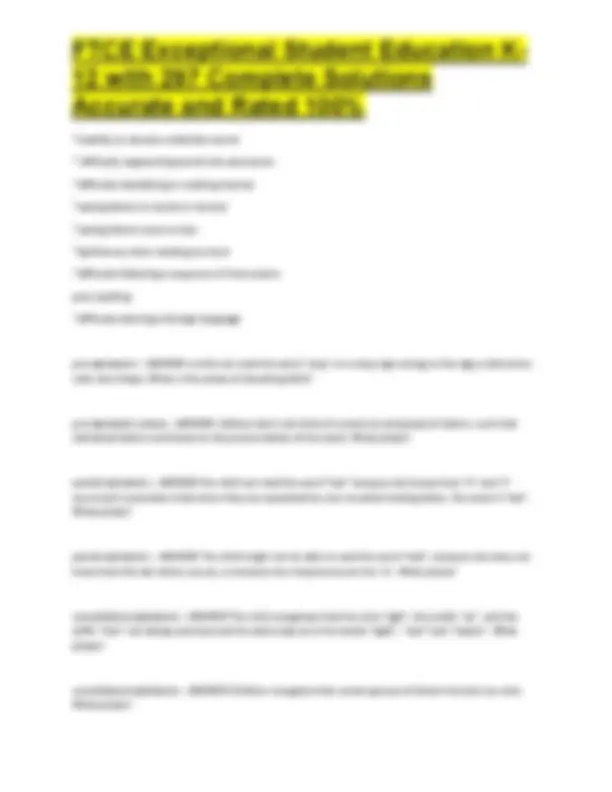
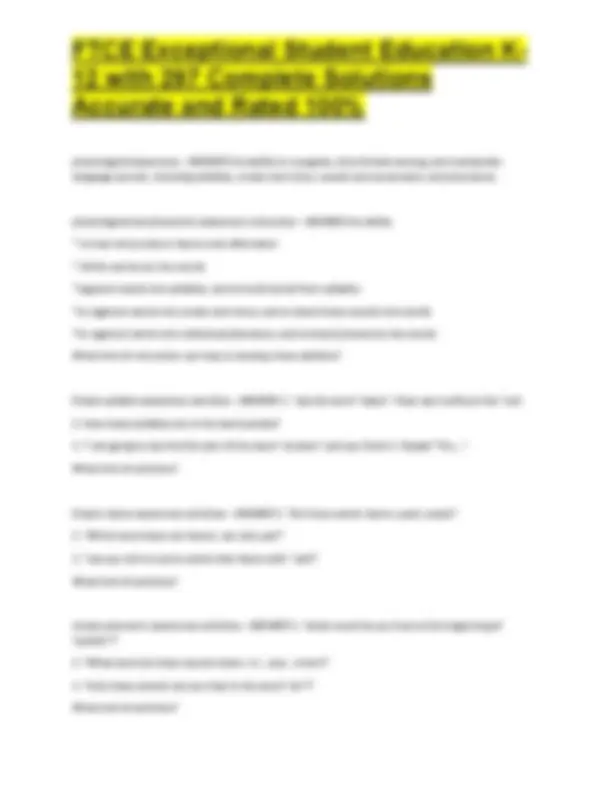
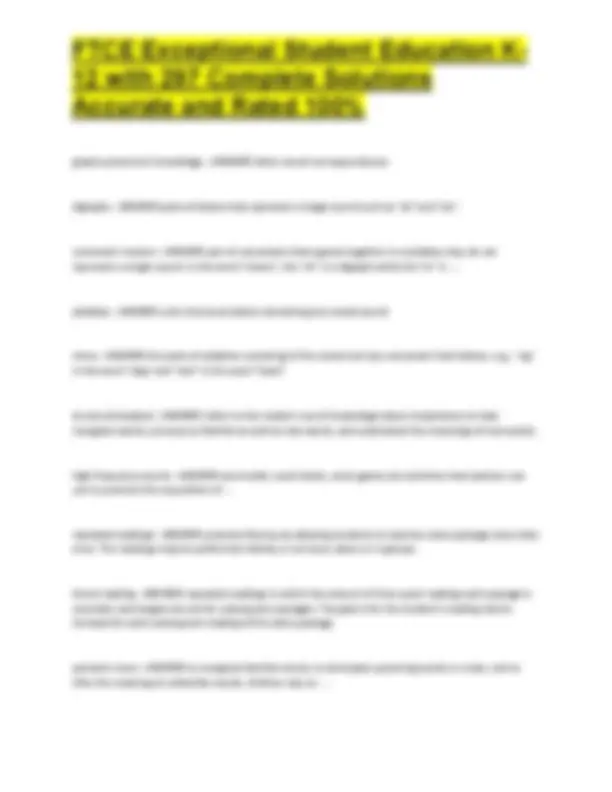
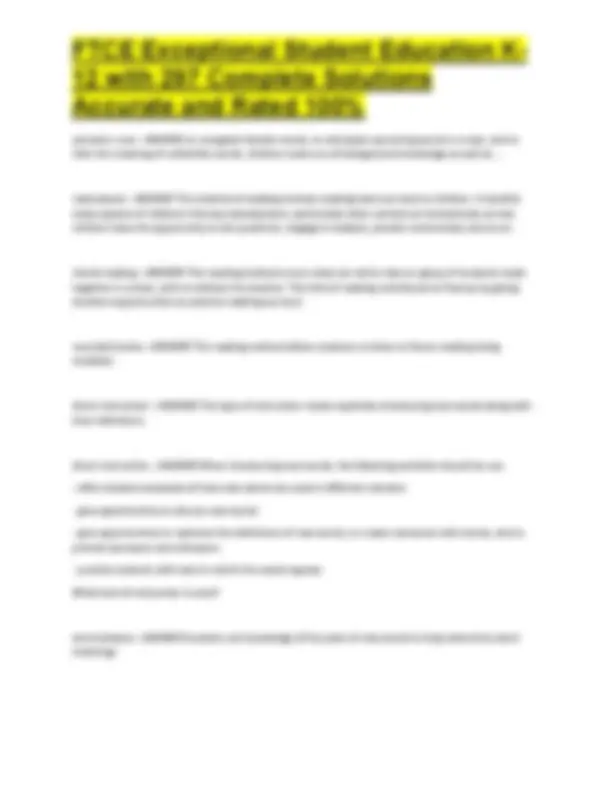
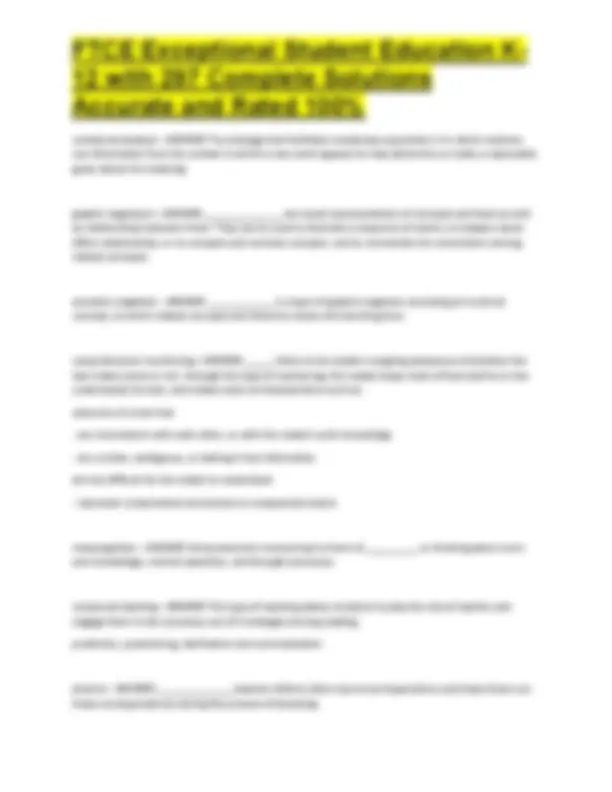
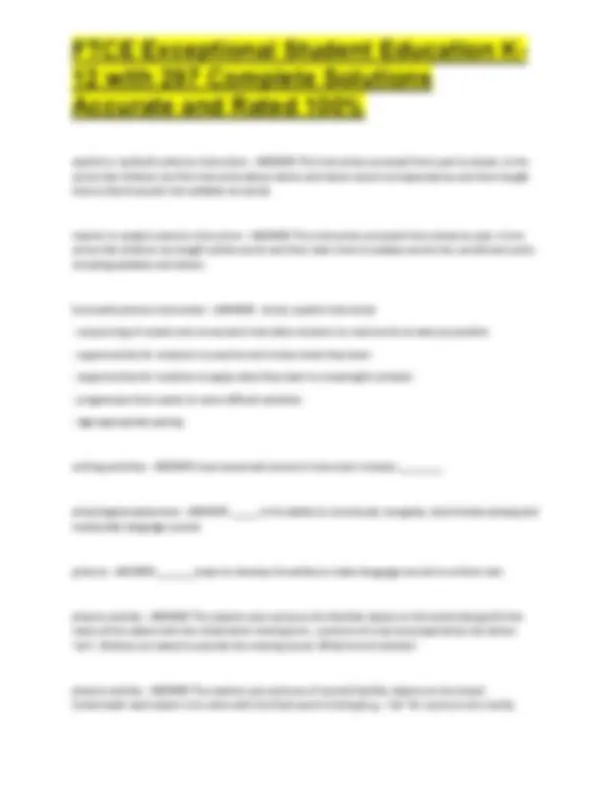
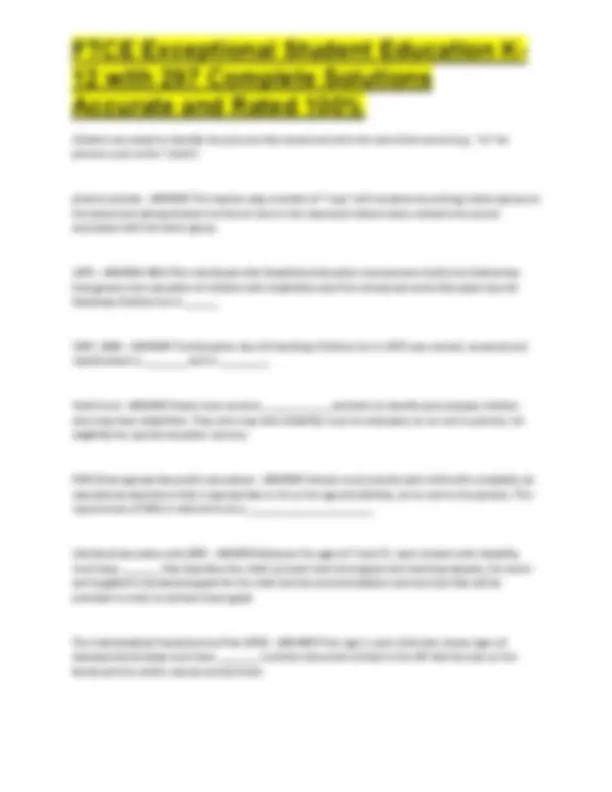
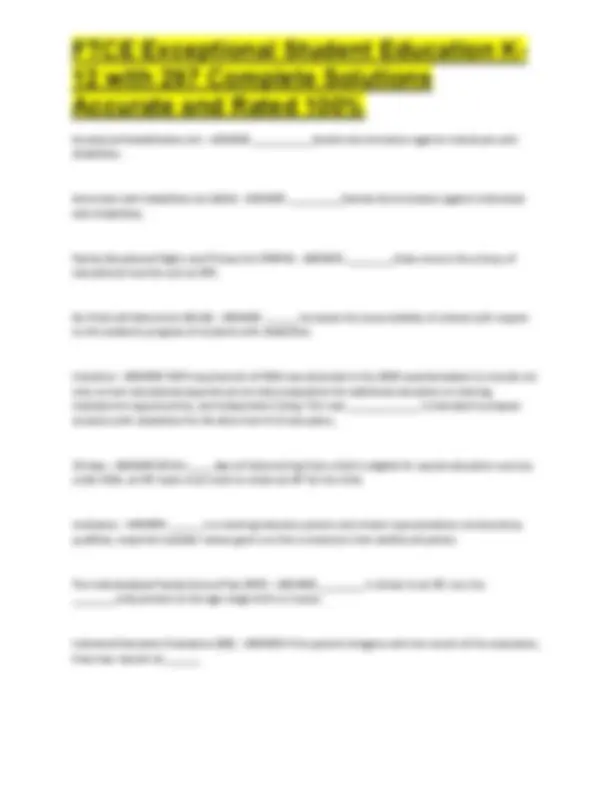
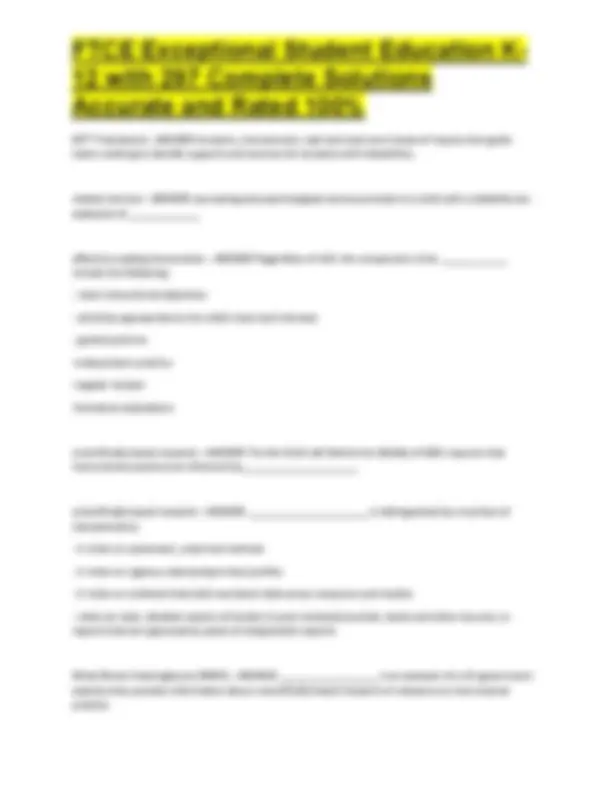
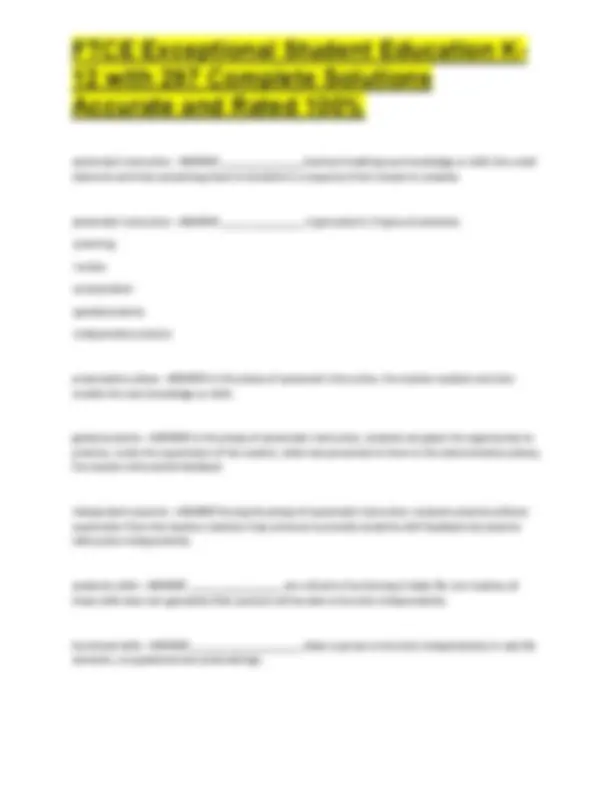
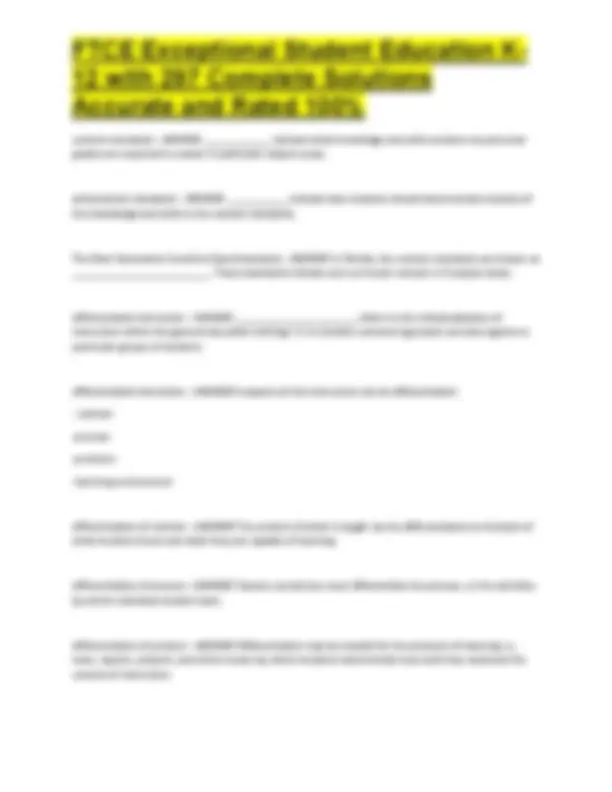
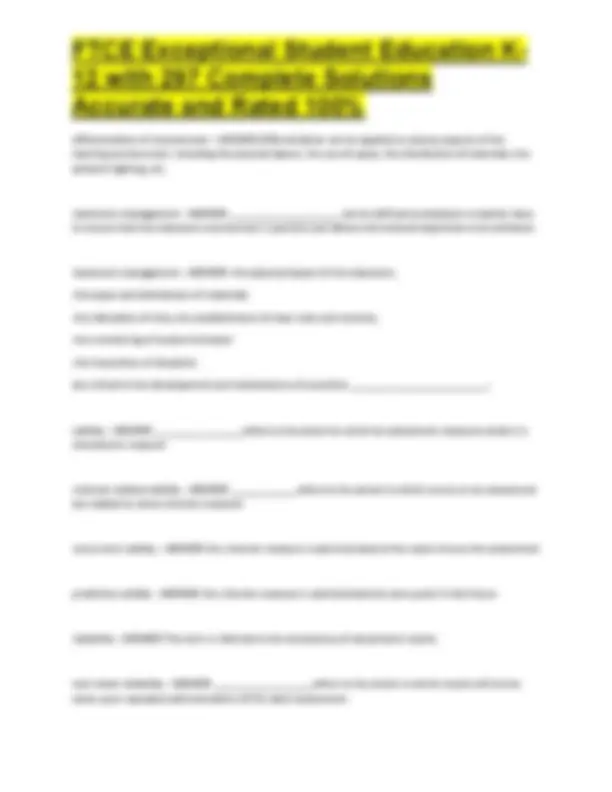
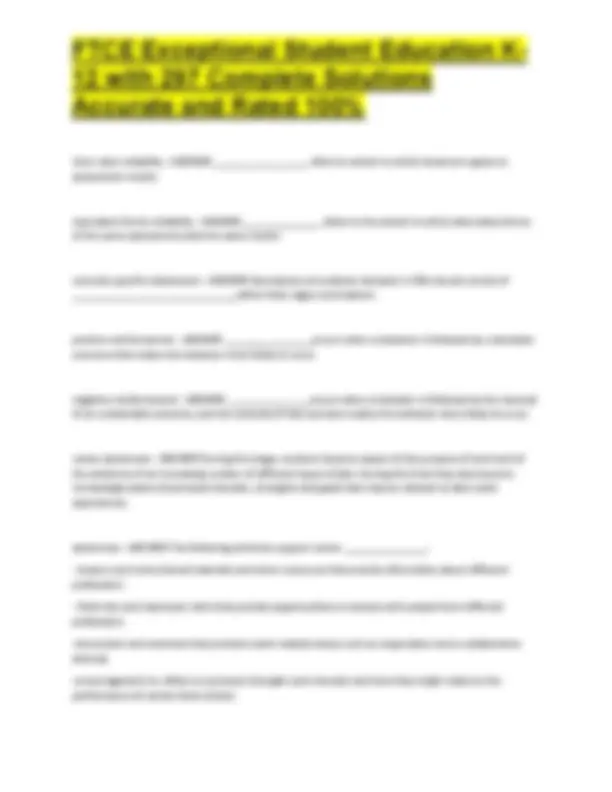
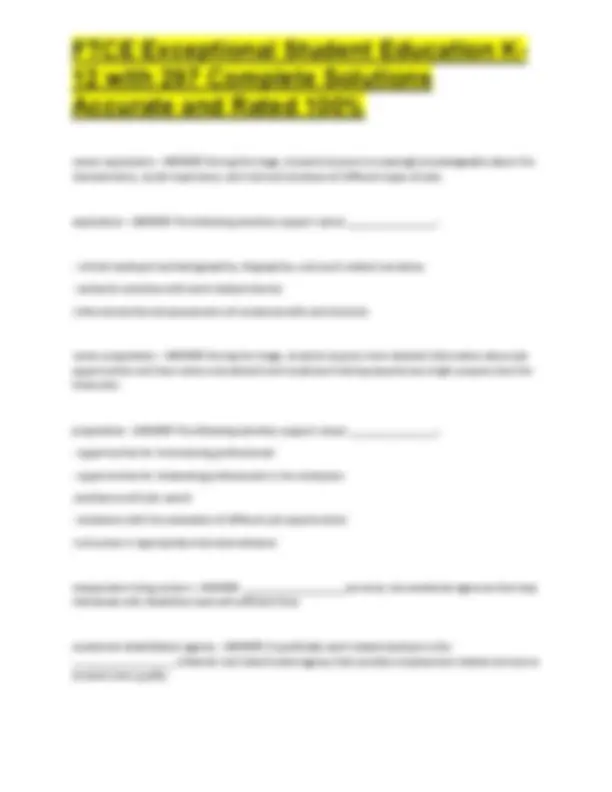
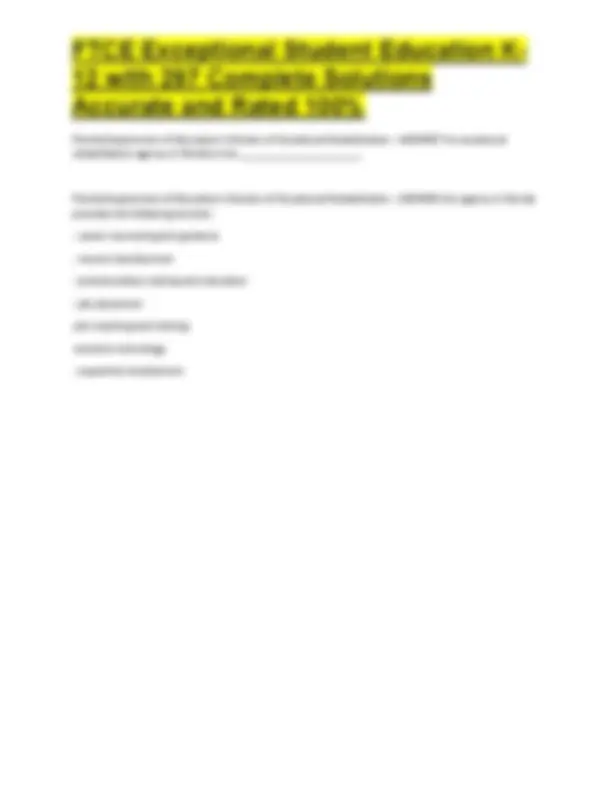


Study with the several resources on Docsity

Earn points by helping other students or get them with a premium plan


Prepare for your exams
Study with the several resources on Docsity

Earn points to download
Earn points by helping other students or get them with a premium plan
Community
Ask the community for help and clear up your study doubts
Discover the best universities in your country according to Docsity users
Free resources
Download our free guides on studying techniques, anxiety management strategies, and thesis advice from Docsity tutors
A comprehensive study guide for the ftce exceptional student education k12 exam, covering key concepts and definitions related to special education. It includes a collection of questions and answers, providing valuable insights into the exam's content and format. The guide is designed to help students prepare for the exam and achieve success.
Typology: Exams
1 / 36

This page cannot be seen from the preview
Don't miss anything!





























Portfolio Assessment - ANSWER A collection of work produced by a student to check student effort, progress and achievement such as a list of books that the student read, a collection of tests and homework, etc.
Florida Alternative Assessment - ANSWER a performance-based alternative assessment of student mastery of Access Point
Disproportionality - ANSWER students from certain racial/ethnic, low socioeconomic status, non- majority linguistic backgrounds and English language learners are overrepresented in special education programs
Test Bias - ANSWER when certain groups consistently score differently from other groups (e.g., females tend to score lower than males)
Curriculum-based measurement (CBM) - ANSWER provides information about student mastery of the general education curriculum
Summative Assessment - ANSWER the process of evaluation student achievement at the end of an instructional period (a quiz administrated by the teacher at the end of an instructional unit, a student's report card, a "high stakes", state achievement test administrated at the end of the school year.
Formative Assessment - ANSWER assessments are "low stakes", their main purpose is not to judge students performance but rather to monitor student progress and identify ways that instruction can be improved overall or tailored to specific students.
Response to Intervention (RTI) - ANSWER The three levels of intensity, or tiers are as in Tier 1 - at risk students receive additional instruction for several weeks; in Tier 2 - students receive more intensive and longer-lasting interventions if they have not responded to Tier 1; in Tier 3 - students receive more intensive, individualized interventions if they have not responded to Tier 2
Sensorimotor stage - ANSWER Piaget divided this stage into six substages: Reflexes (0-1 month); Primary Circular Reactions (1-4 months); Secondary Circular Reactions (4-8 months); Coordination of Reactions (8-12 months), Tertiary Circular Reactions (12-18 months); Early Representational Thought (18- months)
Early Representational Thought - ANSWER 18-24 months, children begin representing things or events with symbols. A significant sensorimotor development is object permanence, i.e., realizing things still exist when they are out of sight.
0-1 month - ANSWER Reflexes (sensorimotor stage) What age?
1-4 months - ANSWER infants find accidental actions like thumb-sucking pleasurable and then intentionally repeat them (Primary Circular Reactions of sensorimotor stage) What age?
4-8 months - ANSWER Secondary Circular Reactions (Sensorimotor stage): infants intentionally repeat actions to evoke environmental effects. What age?
8-12 months - ANSWER Coordination of Reactions (sensorimotor stage): children repeat actions intentionally, comprehend cause and effect and combine schemas (concepts). What age?
12-18 months - ANSWER Tertiary Circular Reactions (sensorimotor stage): children experiment with trial- and-error. What age?
18-24 months - ANSWER Early Representational Thought (sensorimotor stage): children begin representing things and events with symbols. A significant development is Object Permanence, i.e., realizing that thing still exist when out of sight. What age?
The Transition plan (Form 1 of the IFSP - Individualized Family Support Plan) - ANSWER The paperwork that needs to be completed after the transition conference. the IFSP is needed for any child with developmental delays who attends the Early Step Program.
Voluntary Pre-Kindergarten Program - ANSWER the program enacted in 2004, which is designed to prepare four-year-old children for kindergarten and lay the foundation for their success is know as
Performance-based assessment - ANSWER assessment that measures learning processes
Norm-based assessments - ANSWER Assessments that give us some idea of what students need to know to achieve grade level performance are referred as
Informed consent - ANSWER Parents being noticed in their native language of all educational activities to be conducted during a nondiscriminatory evaluation of their child is called
Curriculum based assessments - ANSWER Assessments that are used to determine how a student is performing in or mastering the actual curriculum.
Porfolio Assessment - ANSWER a collection of work systematically collected by a teacher to determine learning gains and current performance level.
indirect instruction - ANSWER inquiry learning/discovery learning is when students construct meaning on their own.
direct instruction - ANSWER Reviewing the previous day's work, presenting new concepts or skills, providing guided student practice, providing feedback, providing independent student practice and reviewing frequently are key elements of what kind of instruction?
glossary - ANSWER an alphabetical collection of terms and their meanings usually found in the form of an appendix to a book
clarifying - ANSWER When focusing on comprehension, if students pay close attention to whether or not the text is making sense to them, they are using the comprehension strategy know as
effective reading instruction - ANSWER using appropriate and ongoing screening, assessments, and progress monitoring; providing intensive instruction; and obtaining early intervention when needed are directly connected to
Strategic competence - ANSWER it is an aspect of mathematical proficiency, an ability to formulate and conduct mathematical problems.
Treatment fidelity - ANSWER the teaching practice as it was provided in research is called....
Interpreting the meaning of the common core standard - ANSWER When working with standards, what will be your fist task?
generalization - ANSWER The student is able to transfer information across settings and can use the information learned. So, when a target behavior transfers across settings, persons,, and materials, which stage of learning has been completed?
to practice a skill that students have already learned. - ANSWER What is the purpose of using independent learning as a grouping format?
electronic books - ANSWER Students who have auditory discrimination difficulties may benefit from...
trade books - ANSWER examples of supplemental reading matirials
Functional behavior assessment - ANSWER Data from progress monitoring should be reviewed systematically to make necessary adjustment to intervention. One process that works hand-in-hand with progress monitoring is
ecological assessment - ANSWER Since the student is expressing an interest in a specific location, this assessment involves carefully examining the environment in which the activity actually occurs. What type of instructional procedures could determine successful adaptive life skills at this location for the student?
placement - ANSWER The phase of career development that occurs during the final years of high school
Preparation - ANSWER the phase of career development that occurs in elementary school but becomes a priority at high school level.
awareness - ANSWER tthe phase of career development that occurs in elementary and extends through middle school
exploration - ANSWER the phase of career development that begins at the middle school level and continues into the high school years.
preparation stage - ANSWER It is at this stage that students develop coordination their employment preparation skills. Students will focus on obtaining job-seeking skills, as well as job-specific skills through paid and non-paid experiences.
discrepancy between intellectual ability, competence, school achievement, or performance to identify SLD - ANSWER The most recent amendments to the IDEA (2004) include which provision regarding the identification of specific learning disabilities? Prior to this amendment, many educators looked for such a discrepancy as a sign of specific learning disabilities.
COACH model (The Choosing Options and Accommodation for Children, 1998) - ANSWER The model used in planning instruction for students with disabilities is described as an example of "student-direct planning". This collaborative approach as they claim goes "beyond person-centered planning"
The National Council on Disability (NCD) - ANSWER An independent federal agency that makes recommendations to both the President and Congress regarding issues related to disabilities
Summative assessments - ANSWER The type of assessment most often used to evaluate the effectiveness of instruction is ...
Criterion-referenced tests - ANSWER This form of assessment fosters cooperation and is oriented to success.
Speech-language impairments, other health impairments, intellectual disabilities, emotional disturbance) - ANSWER The most recent government data show specific learning disabilities as the largest disability category of students aged 6-21 receiving special education services under the IDEA. What is this category (it includes 4: 18.9%, 9.2, 8.9, 7.7)?
Intensive, direct instruction to individual students - ANSWER When teaching basic mathematics, what kind of instruction is most likely to be needed specifically for students with special needs in a general education classroom?
reliability - ANSWER This term means that a measurement can be replicated many times with consistent findings
validity - ANSWER This term means that something measures what it claims to measure
can be equal to firsthand experience - ANSWER Albert Bandura's research found that observation of modeling...
multilevel teaching practices - ANSWER What is an effective method to teach word recognition to a class of students with many reading levels and diverse needs?
Curriculum-based assessment - ANSWER Assessment that measures students' level of achievement as it relates to what is taught in the classroom, results are used to guide instruction, and it is an accurate indicator of student access to the general education curriculum.
Standardized testing - ANSWER The mechanism used to ensure that students have met common core standards is...
Standardized testing - ANSWER Testing that is used by school districts to ensure students have achievement progress in Common Core State Standards. The test is in the same format for all who take it. It often relies on multiple-choice questions and the testing conditions (instructions, time limits and scoring rubrics) are the same for all students (though accommodations are sometimes made for disabled students).
Norm-based assessment - ANSWER Assessments that give us some idea of what students need to know to achieve grade-level performance are referred to as....
learning the semantic system - ANSWER Wood (1976) describes six stages of syntax acquisition. Stages 1 and 2 - birth to about 2 years: The child is...
simple sentences contain subject and predicate - ANSWER Wood (1976) describes six stages of syntax acquisition. Stage 3 - ages 2 -3 years:
question elements such as word order and interrogative pronouns (where, when, etc) - ANSWER Wood (1976) describes six stages of syntax acquisition. Stage 4 - ages 2,5 to 4 years: The child asks questions adding...
"and" - ANSWER Wood (1976) describes six stages of syntax acquisition. Stage 4 - ages 2,5 to 4 years: To combine sentences , the child begins to use...
embed word within the basic sentence - ANSWER Wood (1976) describes six stages of syntax acquisition. Stage 4 - ages 2,5 to 4 years: The child begins to
complete sentences that include word classes of adult language - ANSWER Wood (1976) describes six stages of syntax acquisition. Stage 5 - ages 3,5 to 7 years: The child uses..
differences within the same grammatical class - ANSWER Wood (1976) describes six stages of syntax acquisition. Stage 5 - ages 3,5 to 7 years: The child is becoming aware of appropriate semantic functions of words and....
commands, requests and promises - ANSWER Wood (1976) describes six stages of syntax acquisition. Stage 5 - about 5 to 20 years: The child begins to learn complex sentences and sentences that imply.....
length or complexity for a child age - ANSWER Syntactic deficits are manifested by the child using sentences that lack....
Semantics - ANSWER It is language content: objects, actions, and relations between objects.
birth to about 2 years, Stage 1 - ANSWER As with syntax, Wood (1976) outlines stages for semantic development.: the child is learning meaning while learning his first words. Sentences are one-word, but the meaning varies according to context. Therefore, "doggie" may mean, "This is my dog", or "There is a dog," etc. What age and stage?
about 2 to 8, Stage 2 - ANSWER As with syntax, Wood (1976) outlines stages for semantic development.: The child progresses to two-word sentences, forms longer sentences, until age 7, things are defined in terms of visible actions. The child begins to respond to prompts (pretty/flower), and at about age 8, he can respond to a prompt with an opposite (pretty/ugly). What age and stage?
begins at about 8, Stage 3 - ANSWER As with syntax, Wood (1976) outlines stages for semantic development.: The child's word meanings relate directly to experiences, operations and processes. Vocabulary is defined by the child's experiences, not adult's. At about 12, the child begins to give "dictionary" definitions, and the semantic level approaches that of adults. What age and stage?
birth to 3 months (receptive) - ANSWER Sequence of language development: turns head toward sounds; responds to familiar voices. What age?
birth to 3 months (expressive) - ANSWER Sequence of language development: coos; gurgles; smiles; produces different cries for tiredness, hunger, pain. What age?
4-7 months (receptive) - ANSWER Sequence of language development: responds to own name; distinguishes among people. What age?
4-7 months (expressive) - ANSWER Sequence of language development: laughs; babbles; expresses emotion vocally. What age?
8 months - 1 year (receptive) - ANSWER Sequence of language development: understanding simple words, commands, gestures. What age?
8 months - 1 year (expressive) - ANSWER Sequence of language development: imitates speech sounds; uses gestures such as pointing; may begin to talk. What age?
1 year-2 years (receptive) - ANSWER Sequence of language development: understand growing number of words. What age?
1 year - 2 years (expressive) - ANSWER Sequence of language development: talks in one- then two-word phrases; produces growing number of words. What age?
2 years - 3 years (receptive) - ANSWER Sequence of language development: participates more actively in conversations. What age?
2 years - 3 years (expressive) - ANSWER Sequence of language development: speaks intelligibly; expresses a range of emotions, desires, comments, questions. What age?
communication deficits - ANSWER Speech and language impairments are types of ...
speech impairments - ANSWER motor speech, articulation, fluency and voice disorders are types of ....
motor speech disorders - ANSWER These speech disorders that reflect anatomical of physiological limitations in the physical mechanisms used to produce speech.
motor speech disorders - ANSWER dysarthria and apraxia are two general categories of ...
dysarthria - ANSWER a weakness or paralysis of the musculature that controls speech, typically resulting from illness or injury. The symptoms vary widely from excessively rapid or slow rate of speech, slurred speech, distorted vowels, unmodulated pitch or word flow, overly nasal speech
apraxia - ANSWER an impairment in the ability to translate speech plans into actual speech.
childhood apraxia of speech (CAS) - ANSWER If the apraxia is not the result of illness or injury, the problem is referred to as...
articulation disorders - ANSWER Disorders that are reflected in difficulties producing certain speech sounds
articulation disorders - ANSWER omissions, substitutions and distortions are types of ...
omissions - ANSWER It occurs when the child leaves out sounds, as in the sentence " I ha a boo" (I have a book").
substitutions - ANSWER It occurs when the child uses an incorrect sound in place of the correct one. In such cases, the incorrect sound is usually easier to imitate (e.g., "wight" instead of "right.")
the ability to distinguish phoneme contrast - ANSWER A child with a phonological disorder does not recognize difference between certain phonemes, and a s a result may pronounce different phonemes the same. So phonological disorders reflect limitations in ...
mixed receptive and expressive language disorder - ANSWER the disorder in which both receptive and expressive language abilities are affected
directive interventions - ANSWER structured activities in which the professional responsible for the intervention models speech, prompts the child for specific responses, and offers incentives for desired responses. Through these techniques, the professional attempts to develop targeted aspects of the child's communication.
naturalistic interventions - ANSWER activities carried out in day-to-day settings in which the professional responsible for the intervention makes use of opportunities for the child to learn. the professionals may be engage in modeling, prompting, and the use of incentives, but he or she will also allow the child's interests to influence the content of communication with the child.
segregated models of instructions - ANSWER In these models of instruction, emphasis is placed on the development of discrete skills. In such models. content areas such as math, science and social studies are treated separately from each other and from instruction in language.
integrated instructions - ANSWER in these models of instructions, content areas overlap with each other and with language, and that language skills such as reading, writing and speaking are independent.
0-1 year - ANSWER Normal development of motor abilities: sits without support
0-1 year - ANSWER Normal development of motor abilities:: develops one- and two-arm control
0-1 year - ANSWER Normal development of motor abilities: crawls and stands
0-1 year - ANSWER Normal development of motor abilities: walks with some aid
0-1 year - ANSWER Normal development of motor abilities: begins to indicate hand preferance
0-1 year - ANSWER Normal development of motor abilities: pincer grasp develops
0-1 year - ANSWER Normal development of motor abilities: loses sight of object and searches for item
0-1 year - ANSWER Normal development of motor abilities: transfer objects from one hand to the other
4-5 years of age - ANSWER Normal development of motor abilities: copies crossed and square lines
4-5 years of age - ANSWER Normal development of motor abilities: cuts on a line
4-5 years of age - ANSWER Normal development of motor abilities: prints of few letters of the alphabet
4-5 years of age - ANSWER Normal development of motor abilities: walks backwards and jumps forward successfully
4-5 years of age - ANSWER walks up and down stairs alternating feet
4-5 years of age - ANSWER Normal development of motor abilities: draws human figures including head and stick arms and legs
0-1 year - ANSWER Normal development of language abilities:responds to sound (loud noises, mother's voice familiar or unfamiliar noises)
can be relatively specific or relatively broad. the instruction is considered desirable because it promotes student interest, because it breaks down artificial barriers between content area (and between language and content) and because it reinforces learning by making connections between content areas.
task-based instruction - ANSWER This type of instruction involves teaching of language by means of age appropriate tasks that require meaningful communication. E.g., language skills may be taught in the context of group activities such as the creation oof a class newspaper or website.
communication boards - ANSWER this "low-tech" technology can be as simple as a piece on paper containing pictures, in which case the student communicates by pointing to individual pictures. It is good for a student with impaired speech who has no other disability.
voice output communication aids (speech-generating device) - ANSWER these devices produce speech. What they say may be pre-recorded, produced by synthesizers, or both. Students with impaired speech but no limitation in mobility may use a keyboard or touch screen to operate such a device. Students with limited mobility may use movements of head and eyes to operate the device.
alphabetic principle - ANSWER the understanding that letters represent sounds in systematic and predictable ways, i.e., knowledge of the relationship between spoken and written words.
alphabet knowledge - ANSWER the ability to name the letters of the alphabet and recognize these letters in print
phonological awareness - ANSWER the ability to consciously recognize, discriminate among and manipulate language sounds such as phonemes and syllables, i.e., awareness that spoken words are composed of units of sounds
sight words - ANSWER high-frequency words (the, and) are automatically recognized and become part of children's growing set of...
fluency - ANSWER the ability to read quickly, effortlessly, accurately and expressively.
decoding - ANSWER the sounding out of words
observational assessment - ANSWER checklists, rating scales, duration records, time-sampling records and anecdotal records are examples of ....
rubric - ANSWER authentic assessments can take on many forms, for example, students may be assessed by means of ....
portfolio assessment - ANSWER It's a collection of work produced by a student over time. The goal of this assessment is to gauge student effort, progress and achievement through examination of many different kinds of work that student has produced in a particular class or related to a specific theme.
reading to learn stage - ANSWER this stage is marked by improvements in children's decoding skills, increases in the number of sight words they automatically recognize, and a deeper understanding of the trading process and the properties of texts.
reading to learn stage - ANSWER The abilities that are well-developed but continue to progress during this stage include the ability to:
apply knowledge of letter-sound correspondences to different words
infer meaning from context
make predictions about what will happen in a story
identify text structure
read critically
*shift between close reading and skimming
*read with fluency
self-correct during reading
read independently